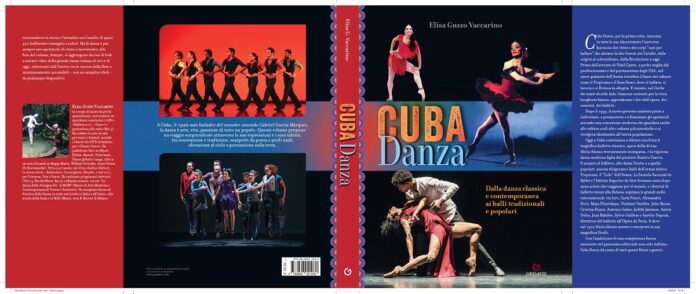Non vi è forse modo più efficace di esprimere il rapporto tra l’isola di Cuba e la danza in ogni sua forma che il titolo del nuovo lavoro di Elisa Guzzo Vaccarino: Cuba Danza (Gremese Editore), si lascia infatti leggere anche come una frase minima, in cui tutta la terra cubana sembra trovarsi impegnata a danzare. Cuba, dunque, danza. In molti modi. Tutti quelli che l’autrice, in maniera magistrale, ricostruisce nella sua scrittura limpida e dettagliata, restituendo al lettore un quadro completo della complessa storia cubana con le discipline tersicoree e non solo.
Nei suoi diciotto capitoli il libro ripercorre gli snodi fondamentali di questo legame, ritessendone la trama. Sin dalle pagine introduttive uno dei nomi portanti di questa vicenda compare in tutta la sua vivace potenza: è Alicia Alonso (cap. 2) a dominare il panorama del balletto cubano, sebbene questo la preceda (cap. 1) e proceda oltre di lei, nella dinastia che condivide il suo nome (cap. 3), nel luogo che ne serba il marchio, il Ballet Nacional de Cuba (cap. 4), e nell’arte che qui si crea, con i ballerini rimasti isolani (cap. 5) e quelli ormai cosmopoliti (cap. 6), con i coreografi locali (cap. 7) e le loro creazioni (cap. 8).
Forse nulla di ciò che caratterizza in maniera così icastica il balletto cubano, la sua forza elegante, la pulizia dei suoi virtuosismi, l’equilibrio dei corpi e delle parti, sarebbe comprensibile se non si riconoscesse che la danza a Cuba non è solo quella classica accademica. Ciò è valido sia per l’impressionante mole di esperienze nell’ambito del moderno (cap. 9) e del contemporaneo (cap. 10), sia per le tradizioni passate e presenti di quello che, prima di essere il terreno della sperimentazione politica castrista, è stato un paese decolonizzato. Alla linfa multiculturale del danzare cubano sono dedicati gli ultimi tre capitoli del volume, in cui l’autrice tratteggia con tinte vivissime rispettivamente il percorso di riappropriazione delle radici africane (cap. 16), l’evoluzione e la diffusione delle danze popolari, nella varietà delle loro manifestazioni (cap. 17), e la pulsante vitalità del Tropicana, baricentro corporeo di un Paese aperto alle possibilità del mondo circostante (cap. 18).
All’incrocio di queste linee di sviluppo, Cuba oggi: dalle molteplici strade che l’eredità di Ramiro Guerra ha preso (cap. 11) alle innovazioni che hanno accompagnato la svolta del millennio (cap. 12), dalle sperimentazioni più recenti (cap. 14) alla fondazione di istituzioni educative che sappiano costruire il futuro (cap. 15), e, al centro, l’esperienza di Carlos Acosta che ha portato la danza a lo cubano ovunque nel mondo (cap. 13).
Corredato da numerosissime fotografie, da una preziosa bibliografia ragionata e da un repertorio videografico, fruibile anche tramite l’utilizzo dei molti QR-code nei diversi capitoli, il lavoro di Elisa Guzzo Vaccarino riesce davvero a trasmettere come un ritmo contagioso il senso, magnifico, della cubanìa danzante, vincendo la sfida, da lei stessa definita titanica, di raccontare un intero universo. Che danza.
Cuba dances
There is perhaps no more effective way of expressing the relationship between the island of Cuba and the dance in all its forms than the title of Elisa Guzzo Vaccarino‘s new book: Cuba Danza (Gremese Editore) In fact, it can be read even as a minimal sentence, in which the whole Cuban land seems to be engaged in dancing. Cuba, therefore, dance. Through a clear and detailed writing, the author gives the reader a complete picture of the complex Cuban history from the Terpsichore’s disciplines and beyond.
In its eighteen chapters the book goes over the fundamental links of this bond. From the introductory pages, one of the leading names of this story is Alicia Alonso (chapter 2). She dominates the panorama of Cuban ballet, although the ballet precedes her (chapter 1) and proceeds beyond her, in the dynasty that shares its name (chapter 3), in the place that keeps its trademark, the Ballet Nacional de Cuba (chapter 4), and in the art that is created here, with the dancers who remained islanders (chapter 5) and those who are by now cosmopolitan (chapter 6), with local choreographers (chapter 7) and their creations (chapter 8).
Perhaps nothing of what characterizes Cuban ballet in such a realistic way, its elegant strength, the cleanliness of its virtuosity, the balance of bodies and parts, would be understandable unless we remember that Cuba is not just ballet. This is valid both for the impressive amount of experience in the modern (chap. 9) and contemporary (chap. 10), and for the past and present traditions of what was a decolonized country, before being the terrain of Castro’s political experimentation. The last three chapters of the volume are dedicated to the multicultural lymph of Cuban dancing, in which the author outlines with vivid colors respectively the path of reappropriation of African roots (chapter 16), the evolution and diffusion of popular dances, in every variety of their manifestations (chap. 17), and the pulsating vitality of the Tropicana, the country’s center of gravity which is opened to the possibilities of the surrounding world (chap. 18).
At the crossroads of these lines of development, there is today’s Cuba: from the many paths that Ramiro Guerra’s legacy has taken (chap. 11) to the innovations that accompanied the turn of the millennium (chap. 12), from the most recent experiments (chap. 14) to the foundation of educational institutions that know how to build the future (chapter 15). At the center, the experience of Carlos Acosta who brought the Cuban way of dancing all over the world (chapter 13).
The work of Elisa Guzzo Vaccarino really manages to transmit with a contagious rhythm the magnificent sense of Cuban dancing, winning the challenge, defined by herself as titanic, to tell an entire universe. Her work is also accompanied by numerous photographs, a precious annotated bibliography and a videographic repertoire, enjoyable through the many QR-codes in the various chapters. What a dance.







